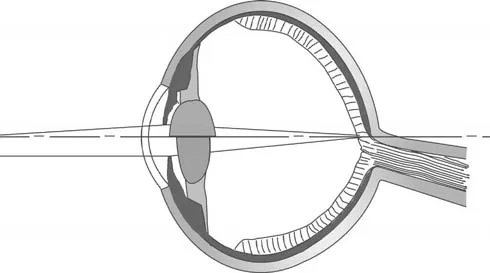![]()
PART ONE
Lighting concepts and resources
![]()
| Living in the luminous field | CHAPTER 1 |
We are in intimate contact with the luminous field through our eyes, except when we are asleep, just as we are in intimate contact with the atmosphere through our lungs. All the time we are absorbing electromagnetic energy which we call light and we are evaluating, consciously or subconsciously, the messages it dictates to us about the world around us.
The data we receive in this way is continually compared with previously received information to help us with this evaluation. For example, you are sitting in a room which has a wall which is brown in colour. The sun is streaming through the window and its light falls on one end of the wall. The other end of the wall is in dark shadow. Thinking about the appearance of the wall, you realise that what you see is that the end of the wall in dark shadow appears dark brown; the middle section of the wall appears light brown; and the end of the wall, where the sunlight falls, is a pale, almost luminous, brown. However, you know that the wall is painted only one colour, a particular shade of brown. You appreciate that the impression of different colours is caused by the way in which the light falls upon the wall. Such an interpretation depends upon the brain evaluating the whole scene in a routine way.
A similar thing happens when you look at a white ceiling in a daylit room. You may see various shades of grey, as well as white, but you know that the ceiling is actually painted white, not grey. It would be possible to deceive the eye/brain combination with a carefully created visual scene, but in most contexts the brain makes the correct deduction.
Appreciation of this ability of the brain to use previously absorbed information to evaluate the meaning of a visual scene is obviously important in understanding how people react to the lighting they encounter. It emphasises the point that often their feelings and opinions are related to evaluations of which they are not fully aware.
In every developed human being there is a vast store of reference data that the senses use to evaluate the present. Much of that data is shared human experience and awareness of the past. Since sight is one of the primary senses, much of that reference data is stored in visual images with associated emotional reactions. Basic to this is the experience of warm and sunny days and also of cold and dark nights, while there are others linked to private memories. Each person has a vast store of memories, many of which emerge as emotions only when particular situations are encountered. Since people vary in this way, some like certain things which others dislike. Therefore, it is not possible to arrive at a common consensus about such subjective things as art, decoration and, sometimes, lighting.
A ‘natural’ designer is someone who has absorbed the experiences of living in the luminous field in such a way that they find it easy to create luminous fields themselves that are appropriate for the building or space to be lit, and their creativity is rather like that of Beethoven who, when asked where his musical creativity came from, apparently replied that it came ‘unbidden’.
However, most designers need the conscious observation of the luminous field as it presents itself day by day, together with the effort of analysis, so that ideas can come to them when bidden in order that good lighting designs are achieved. Observation of the luminous field is the key to being able to create good lighting schemes; and in lighting, as with other areas of design, there is often a tension between the past and the present.
In some spaces and situations it is sequence that is important – for instance, when moving from space to space, such as passing through a museum, department store or supermarket – while in other types of building it is the need to locate a particular service or to find the means of escape in an emergency. In other spaces, such as a waiting area, a feeling of relaxation rather than stimulation is required.
The first stage in any design is simplification – finding one word or sentence to describe the aim of the space that the lighting is to assist – inspiration, stimulation, relaxation, progression, interest, awareness, performance, satisfaction, etc.
The strength of the lighting attributes to be provided will also depend upon the time spent in a space. For instance, a theatrical type of display that has some very bright lights may be ideal for short-stay stimulation but disastrous for permanent occupation.
Design means exploring the full purpose of the lighting and carefully crafting the solution. Start by simplifying, but end by avoiding oversimplification. Some designers would claim to have no need of calculation, measurement or the like but, in the final analysis, no design can be translated into reality without the fruits of measurement and evaluation. It is this interaction of art and science that has always been the key that has made the world function and worth living in.
Our response to the luminous field is also affected by other factors, such as our physical state. For example, if we have a headache then our tolerance of the amount of light we can cope with is usually reduced and we reach for dark glasses. In terms of emotional state, bright sunshine stimulates us with feelings of well-being, whilst a heavil...

